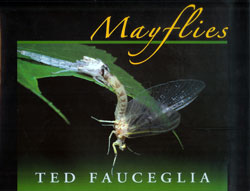Review: Mayflies
TED FAUCEGLIA set out thirty years ago to do something that would seem daunting to the even the most adept photographers: create on-stream images of mayflies in various stages of their life cycles, capturing all of the natural light, colors and details. Considering the differences in behavior of the many species — not to mention the problems identifying them — only his passion for the subject could have led him to finish the project. Indeed, when I asked him recently whether he could do a similar book for mayflies of the western United States, he said, “If I have three more decades to photograph the flies, sure.”
Ted Fauceglia is known in the fly fishing publishing world as the foremost photographer of insects and fly patterns. He’s been inspiring awe for quite some time, so most of us expected a lot out of Ted’s first book. And we got it.
Mayflies is first and foremost a record of fascinating images of insects. No one does this kind of photography better, and few even have the technical skills to achieve a refined balance of light, focus and color while photographing such tiny, subtle subjects. It’s easy to be fooled into thinking this is just the first real coffee-table book for entomologists. But the author brings with him something even more valuable: a vision of how insects are perceived by both fish and fisherman. This is where the other contents of the book — the narrative about lifecycles and the fly patterns used to imitate their various stages — glue things together. Here is Fauceglia describing the blue-winged olive nymph emergence:
Intelligently, Fauceglia, though a master fly tier in his own right, chose the experts in various categories of patterns and species to author the ties he photographed for each chapter. If someone like a Dave Rothrock could tie a cream cahill nymph better, he asked them to do it. Some of the other tiers represented in the book are Dave Ellis, Kelly Galloup, Chris Helm, Ed Jaworowski, Mike Mercer, and Art Scheck. To the uninformed this might look merely convenient, but it voices the underlying message of this book, which is that over time the master tiers have learned to tie flies that trout choose as food, not just flies that look to anglers like natural insects. So for the first time in print, we get to see the differences between a mayfly viewed in almost perfect natural light and the flies that, to a trout, best imitate them.
Mayflies will remain a “photography” book for many fly fishers. It’s just too hard to stop looking at the images, which achieve a National Geographic-like intimacy and eye-widening level of detail. But there is much more between the covers here, and no doubt the thinking involved will inspire many others along the same path of choosing and tying flies according to a sophisticated understanding of insect life cycles. For these anglers, Mayflies is not just a pretty book but an invaluable reference.












